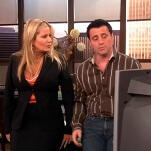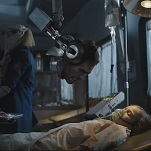Bob: The Complete Series

Has there ever been a star easier to build a TV series around than Bob Newhart? Take the affable comedian and stick him in the middle of a bunch of oddballs, then let him stammer a bit as he tries to figure out how he ended up in this weird world. It’s instant comic gold, a recipe that worked in one sketch series, the ’60s’ The Bob Newhart Show, and two all-time classic sitcoms, the ’70s’ The Bob Newhart Show and the ’80s’ Newhart. Ideally, he’ll have a surprisingly sexy wife who has a way with a sly one-liner, and a bunch of co-workers who seem too strange to be believed. Give the man ample opportunity to confront the oddities of the modern world, and it’s all but certain to be a success.
Despite all of this, though, Newhart’s two most successful sitcoms took time to find their voices. Indeed, Newhart didn’t really work until its third and fourth seasons, a remarkable amount of time for any TV show. To that end, the comedian’s ’90s sitcom, Bob, which aired for two seasons on CBS, might have the most consistent first season of any Newhart vehicle. Creators Cheri Steinkellner, Bill Steinkellner, and Phoef Sutton took everything they learned in the more farcical late seasons of Cheers and combined that with everything learned from watching Newhart’s previous sitcoms. There are a few tired moments when the technological advances of the ’90s make Newhart seem like the protagonist of a Readers Digest anecdote—a bit about call-waiting in the pilot is particularly dire—but for the most part, the series has a remarkably solid foundation.
Newhart plays Bob McKay, a greeting card artist who’s contacted by a comic book company that loves a book he put together in the ’50s called Mad-Dog. The company wants to resurrect Mad-Dog—a veterinarian with the superpowers of a Doberman pinscher—and it wants McKay on board to work with young genius Harlan Stone (a terrific John Cygan), clearly modeled after Frank Miller, Alan Moore, and the other writers and artists who reinvented comics in the ’80s. Through contrived circumstances, Newhart and Cygan end up doing the comic together, and Mad-Dog looks poised to conquer the comics market, so long as the two can overcome their bizarre coworkers and Bob’s genially daffy home life.
Bob’s producers maximize the star’s encounters with weirdoes and goofballs, but they also came up with a surprisingly strong setup for a sitcom. In most shows like this, the workplace setting is far more interesting than the home setting, but Bob’s domestic life is just as funny as the strange stuff at the office. Carlene Watkins, in particular, feels like a perfect combination of Newhart’s two previous sitcom wives, while Cynthia Stevenson (who would go on to have a long string of failed ’90s sitcoms) makes so much of a cliché role—single daughter looking for love—that the producers quickly gave her much more to do and trusted her with the series’ strongest emotional material. This threesome, combined with Cygan’s gleeful misanthropy, makes for a strong comedic team.







































